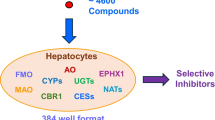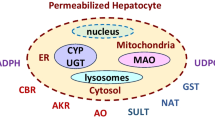Abstract
Purpose. CYP3A and P-gp both function to reduce the intracellular concentration of drug substrates, one by metabolism and the other by transmembrane efflux. Moreover, it has been serendipitously noted that the two proteins have many common substrates and inhibitors. In order to test this notion more fully, systematic studies were undertaken to determine the P-gp-mediated transport and inhibitory characteristics of prototypical CYP substrates.
Methods. L-MDR1, LLC-PK1, and Caco-2 cells were used to evaluate established CYP substrates as potential P-gp substrates and inhibitors in vitro, and mdrla deficient mice were used to assess the in vivo relevance of P-gp-mediated transport.
Results. Some (terfenadine, erythromycin and lovastatin) but not all (nifedipine and midazolam) CYP3A substrates were found to be P-gp substrates. Except for debrisoquine, none of the prototypical substrates of other common human CYP isoforms were transported by P-gp. Studies in mdrla disrupted mice confirmed that erythromycin was a P-gp substrate but the CYP3A inhibitor ketoconazole was not. In addition, CYP3A substrates and inhibitors varied widely in their ability to inhibit the P-gp-mediated transport of digoxin.
Conclusions. These results indicate that the overlap in substrate specificities of CYP3A and P-gp appears to be fortuitous rather than indicative of a more fundamental relationship.
Similar content being viewed by others
REFERENCES
F. P. Guengerich. Cychrome P450: Structure, mechanism, and biochemistry, P. R. Ortiz de Montellano. (ed.), Human cytochrome P450 enzymes, Plenum Press, New York, 1995, pp. 473-535.
P. Maurel. Cytochromes P450: Metabolic and toxicological aspects, C. Ioannides (ed.), The CYP3 family, CRC Press, Inc., Boca Raton, 1996, pp. 241-270.
K. E. Thummel and G. R. Wilkinson. In vitro and in vivo drug interactions involving human CYP3A. Ann. Rev. Pharmacol. Toxicol. 38:389-430 (1998).
M. F. Fromm, R. B. Kim, C. M. Stein, G. R. Wilkinson, and D. M. Roden. Inhibition of P-glycoprotein-mediated drug transport: A unifying mechanism to explain the interaction between digoxin and quinidine. Circulation 99:552-557 (1999).
M. M. Gottesman and I. Pastan. Biochemistry of multidrug resistance mediated by the multidrug transporter. Ann. Rev. Biochem. 62:385-427 (1993).
D. Levêque and F. Jehl. P-glycoprotein and pharmacokinetics. Anticancer Res. 15:331-336 (1995).
V. J. Wacher, C.-Y. Wu, and L. Z. Benet. Overlapping substrate specificities and tissue distribution of cytochrome P450 3A and P-glycoprotein: implications for drug delivery and activity in cancer chemotherapy. Mol.Carcinogen. 13:129-134 (1995).
J. M. Ford and W. N. Hait. Pharmacology of drugs that alter multidrug resistance in cancer. Pharmacol. Rev. 42:155-199 (1990).
J. M. Ford. Experimental reversal of P-glycoprotein-mediated multidrug resistance by pharmacological chemosensitisers. Eur. J. Cancer 32A:991-1001 (1996).
K. M. Barnes, B. Dickstein, G. B. Cutler, T. Fojo, and S. E. Bates. Steroid transport, accumulation, and antagonism of P-glycoprotein in multidrug-resistant cells. Biochemistry. 35:4820-4827 (1996).
S. Scala, N. Akhmed, U. S. Rao, K. Paull, L.-B. Lan, B. Dickstein, J.-S. Lee, G. H. Elgemeie, W. D. Stein, and S. E. Bates. P-glycoprotein substrates and antagonists cluster into two distinct groups. Mol.Pharmacol. 51:1024-1033 (1997).
P. J. Dempsey, K. S. Meise, Y. Yoshitake, K. Nishikawa, and R. J. Coffey. Apical enrichment of human EGF precursor in Madin-Darby canine kidney cells involves preferential basolateral ectodomain cleavage sensitive to a metalloprotease inhibitor. J. Cell. Biol. 138:747-758 (1997).
R. B. Kim, M. F. Fromm, C. Wandel, B. Leake, A. J. J. Wood, D. M. Roden, and G. R. Wilkinson. The drug transporter P-glycoprotein limits oral absorption and brain entry of HIV-1 protease inhibitors. J. Clin. Invest. 101:289-294 (1998).
F. P. Guengerich and R. H. Böcker. Cytochrome P-450-catalyzed dehydrogenation of 1,4-dihydropyridines. J. Biol. Chem. 263:8168-8175 (1988).
R. G. Knodell, S. D. Hall, G. R. Wilkinson, and F. P. Guengerich. Hepatic metabolism of tolbutamide: characterization of the form of cytochrome P-450 involved in methyl hydroxylation and relationship to in vivo disposition. J. Pharmacol. Exp. Ther. 241:1112-1119 (1987).
R. B. Kim, D. O'Shea, and G. R. Wilkinson. Interindividual variability of chlorzoxazone 6-hydroxylation in men and women and its relationship to CYP2E1 genetic polymorphisms. Clin. Pharmacol. Ther. 57:645-655 (1995).
Y. Caraco, G. R. Wilkinson, and A. J. Wood. Differences between white subjects and Chinese subjects in the in vivo inhibition of cytochrome P450s 2C19, 2D6, and 3A by omeprazole. Clin. Pharmacol. Ther. 60:396-404 (1996).
A. K. Chaudhary, F. Belas, S. A. Saleh, C. Wandel, A. J. J. Wood, and I. A. Blair. Quantitation of midazolam and its CYP3A4 metabolites from human plasma using liquid chromatography/tandem mass spectrometry (LC/MS/MS). ISSX Proceedings 10:130(1996).
M. Murray. P450 enzymes. Inhibition mechanisms, genetic regulation and effects of liver disease. Clin. Pharmacokinet. 23:132-146 (1992).
F. P. Guengerich, M. V. Martin, P. H. Beaune, P. Kremers, T. Wolff, and D. J. Waxman. Characterization of rat and human liver microsomal cytochrome P-450 forms involved in nifedipine oxidation, a prototype for genetic polymorphism in oxidative drug metabolism. J. Biol. Chem. 261:5051-5060 (1986).
J. C. Gorski, S. D. Hall, D. R. Jones, M. VandenBranden, and S. A. Wrighton. Regioselective biotransformation of midazolam by members of the human cytochrome P450 3A (CYP3A) subfamily. Biochem. Pharmacol. 47:1643-1653 (1994).
T. J. Rashid, U. Martin, H. Clarke, D. G. Waller, A. G. Renwick, and C. F. George. Factors affecting the absolute bioavailability of nifedipine. Br. J. Clin. Pharmacol. 40:51-58 (1995).
K. E. Thummel, D. O'Shea, M. F. Paine, D. D. Shen, K. L. Kunze, J. D. Perkins, and G. R. Wilkinson. Oral first-pass elimination of midazolam involves both gastrointestinal and hepatic CYP3A-mediated metabolism. Clin. Pharmacol. Ther. 59:491-502 (1996).
J. van Asperen, U. Mayer, O. van Tellingen, and J. H. Beijnen. The functional role of P-glycoprotein in the blood-brain barrier. J. Pharmaceut. Sci. 86:881-884 (1997).
C.-H. Yun, R. A. Okerholm, and F. P. Guengerich. Oxidation of the antihistaminic drug terfenadine in human liver microsomes. Role of cytochrome P-450 3A(4) in N-dealkylation and C-hydroxylation. Drug Met. Disp. 21:403-409 (1993).
R. W. Wang, P. H. Kari, A. Y. H. Lu, P. E. Thomas, F. P. Guengerich, and K. P. Vyas. Biotransformation of lovastatin. IV. Identification of cytochrome P450 3A proteins as the major enzymes responsible for the oxidative metabolism of lovastatin in rat and human liver microsomes. Arch. Biochem. Biophys. 290:355-361 (1991).
E. G. Schuetz, K. Yasuda, K. Arimori, and J. D. Schuetz. Human MDR1 and mouse mdr1a P-glycoprotein alter the cellular retention and disposition of erythromycin, but not of retinoic acid or benzo(a)pyrene. Arch. Biochem. Biophys. 350:340-347 (1998).
P. Chelvan, J. M. T. Hamilton-Miller, and W. Brumfitt. Biliary excretion of erythromycin after parenteral administration. Br. J. Clin. Pharmacol. 8:233-235 (1979).
P. B. Watkins. Noninvasive tests of CYP3A enzymes. Pharmacogenetics 4: 171-184 (1994).
Author information
Authors and Affiliations
Corresponding author
Rights and permissions
About this article
Cite this article
Kirn, R.B., Wandel, C., Leake, B. et al. Interrelationship Between Substrates and Inhibitors of Human CYP3A and P-Glycoprotein. Pharm Res 16, 408–414 (1999). https://doi.org/10.1023/A:1018877803319
Issue Date:
DOI: https://doi.org/10.1023/A:1018877803319




